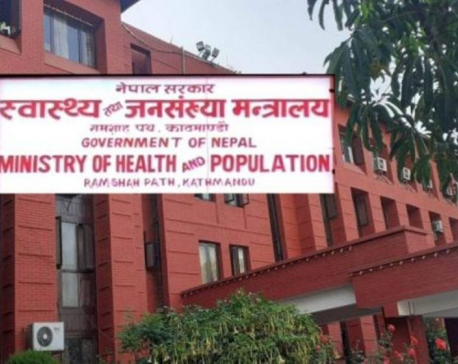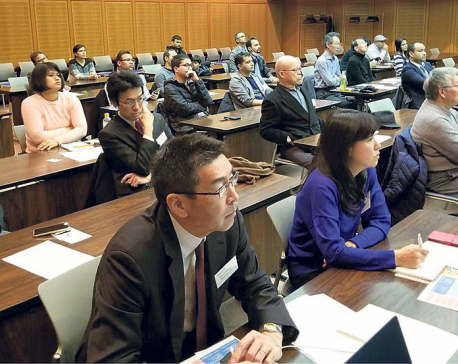
OR
Public health professionals disagree with Oxford University's prediction on COVID-19 situation in Nepal
Published On: September 4, 2020 09:05 AM NPT By: Republica | @RepublicaNepal

KATHMANDU, Sept 4: Nepal's public health professionals have disagreed with a recent report titled "Modeling of COVID-19 Strategies in Nepal".
Issuing a press statement, the public health professionals objected to the report which was jointly published and made public by the UKAID and Oxford Policy Management and University of Oxford projecting COVID-19 cases and deaths in Nepal.
"Nepal is fighting against the COVID-19 pandemic with its capacity within the public and non-state sectors and comparatively doing well among South Asian countries so far. Prediction of the pandemic situation in country is, apparently, a basis of planning to mitigate the problem," read the press statement.
Stating that such predictions should be based on available data and rational assumptions that will reveal the results close to the reality, the health professionals have asserted that wrong predictions will misguide the policy and planning resulting in failure to address the problem.
The health professionals also appreciated Government of Nepal, Ministry of Health and Population for making their official stand public regarding the report.
They also have requested the people not to panic due to unbelievable number of cases and death due to COVID19 projected in the report.
In case of low disruption strategy, the report has predicted that the peak of the epidemic will extend from early June to early September, reaching a maximum of nearly 846,000 new COVID-19 cases per day with less than 10% of cases (75,000) reported to the health system and 49,200 cumulative deaths due to COVID19 by the end of the year.
"In case of medium disruption strategy, the peak of the epidemic will extend from mid-July to early October, reaching a maximum of nearly 548,000 new COVID-19 cases per day with less than 10% (50,000) of cases being reported to the health system and around 5,000 less deaths compared to low disruption strategy," the report released by UKAID and Oxford University stated.
In case of high disruption strategy, peak of the epidemic will extend from mid-June to late October, reaching a maximum of nearly 531,000 new cases per day with less than 10% of cases (46,800) reported to the health system and 11,300 less deaths compared to medium disruption strategy, the report further said.
"We strongly disagree with the results of the modeling report, as these results are nowhere close to the present incidence of new cases and deaths due to COVID-19," read the statement issued by the public health professionals.
Stating that the report has not provided table of monthly cases and deaths which would be easier to compare with the actual reported numbers of Government data, the health professionals said that the report has provided are graphs with difficult to measure scale, which indicate that the peak of daily cases (for example, in medium disruption scenario of total new 548,000 eOV10-19 cases with less than 10% (50,000) actually reported per day) falls towards the last week of August, 2020. This is about 50 times higher than the actual scenario in Nepal.
"This report was completed on May 2020. The scale of panic aside, what if government had accepted this report to spend its scarce resources on such massive scale preparation of hospital beds, ICU beds and ventilators as per requirement of this report. Would it be a proper use of resources or misuse of resources?" the health professionals have questioned.
Believing that such report will mislead the policy and strategy to combat the pandemic and create panic among the people leading to further challenges to manage the problem, the health professionals have asked the following questions to authors and its collaborators.
a. What are basis of :
-Assumption of inputs to the modeling to estimate prediction of new COVID19 cases per day; so that in an span of about 4 months approximately two crore of Nepalese would be COVID-19 positive?
-Assumption of less than 10% of cases reporting to the health system?; -Assumption of such high mortality?;
b. As any careful reading of graph shows, if this prediction fails with a wide margin in Nepal, what is the basis to believe the predictions will come true for September to December 2020?
c. What are the explanations of authors about the mismatch between the prediction in the report and currently reported situation of new COVID-19 cases per day and number of deaths due to COVID-19?
The undersigned health professionals include Dr. Mahesh Kumar Maskey, Dr Sarad Onta, Dr Sadri Raj Pande, Dr Aruna Upreti, Dr Sameer Mani Dixit, Dr Abhinav Vaidya and Dr Rajendra BC.
You May Like This

Health ministry forms 11-member committee to ensure safety of health workers
KATHMANDU, Oct 3: The Ministry of Health and Population has constituted an 11-member committee chaired by Ministry's additional secretary Dr... Read More...

Paving the Way for a Stronger Healthcare System
In a commendable move, Minister of Health and Population, Mohan Bahadur Basnet, has announced a plan to curtail unnecessary foreign... Read More...

Ways to improve healthcare in Nepal discussed in Tokyo
KATHMANDU, Feb 7: Nepali and Japanese health professionals residing in Japan have organized a seminar on improving health care system... Read More...





Just In
- Kushal Dixit selected for London Marathon
- Nepal faces Hong Kong today for ACC Emerging Teams Asia Cup
- 286 new industries registered in Nepal in first nine months of current FY, attracting Rs 165 billion investment
- UML's National Convention Representatives Council meeting today
- Gandaki Province CM assigns ministerial portfolios to Hari Bahadur Chuman and Deepak Manange
- 352 climbers obtain permits to ascend Mount Everest this season
- 16 candidates shortlisted for CEO position at Nepal Tourism Board
- WB to take financial management lead for proposed Upper Arun Project






_20220508065243.jpg)







Leave A Comment